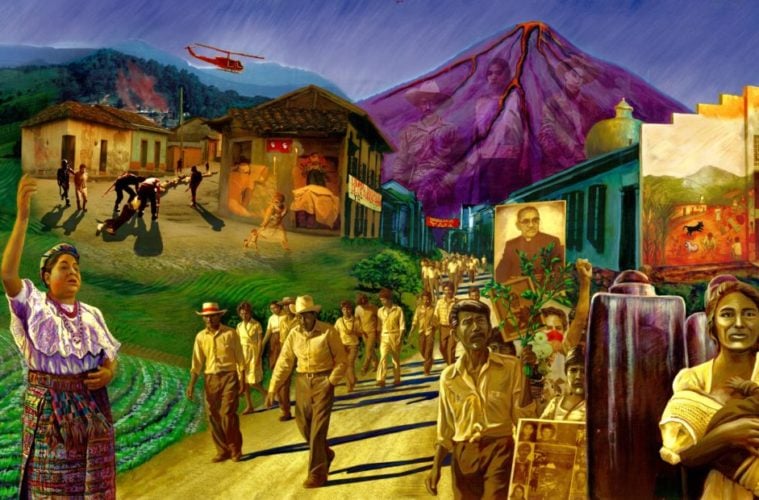The first clue you’re in for something special with Judy Baca: Memorias de Nuestra Tierra, a Retrospective at the Museum of Latin American Art, is the color. Emanating from the work and radiating from the walls, a supercharged, warm and vibrating palette scheme takes over every bit of wall and space; it truly is like walking into one of the paintings. Glowing yellow and deep crimson, royal blue and sun-kissed teal, fertile green and amber earth, highlights of lavender – across landscapes, historical vignettes, intimate personal portraits, performative and symbolic self-portraits, visionary scenes of spirit and magic, apparitions of ancestors, injustices, folklore, feminism, humor, protest and politics, Judy Baca’s palette is a prismatic experience.
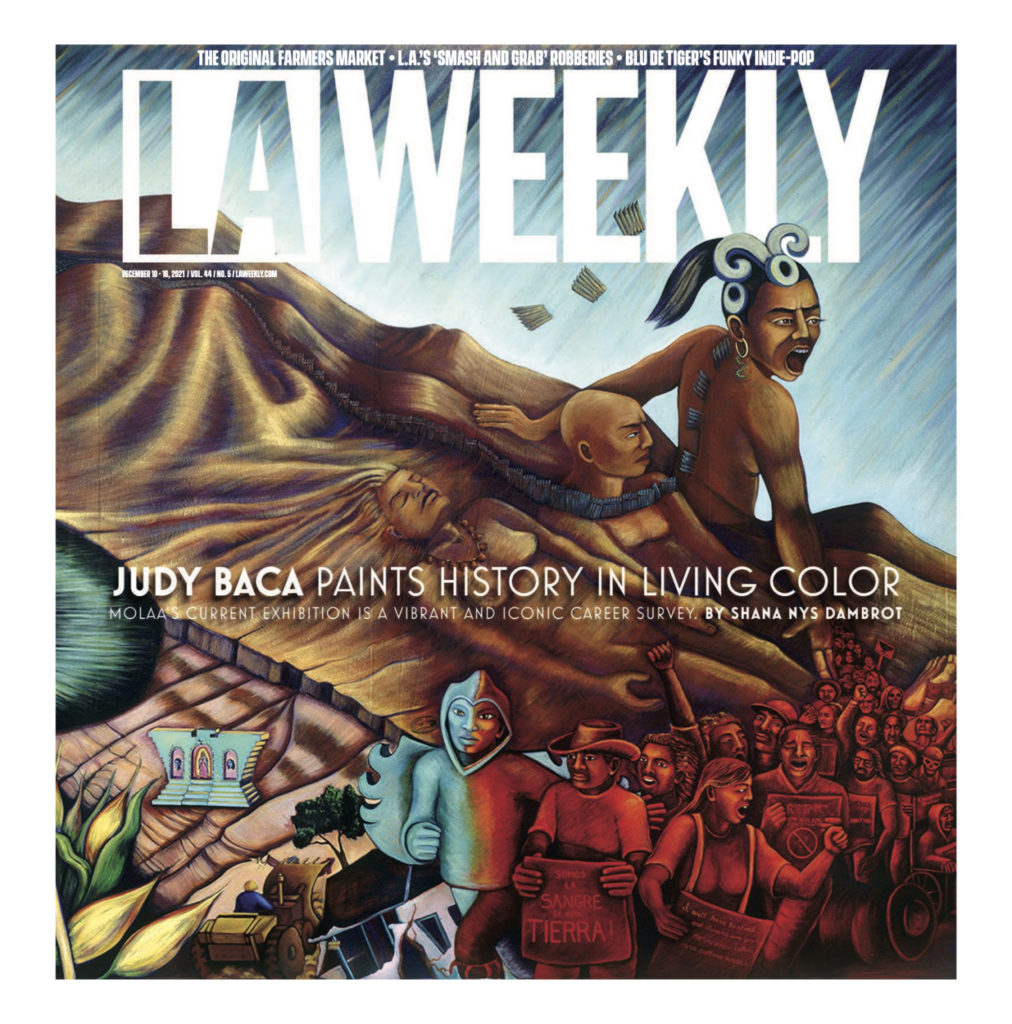
Most people who are aware of Baca’s decades of activity in the Los Angeles art and social justice worlds – and especially at their intersection – know her from The Great Wall project. This half mile long mural, which is still very much in progress, is sited along the Tujunga Wash in the San Fernando Valley, and chronicles the history of California from prehistory until… Well, the goal is to catch up to the present, but right now it’s completed through the 1950s and the ‘60s are in the planning stages. The mural pays special attention to the lesser-known histories of the ethnic groups who historically and currently live here. The exhibition gets to the Wall in dramatic, impressive fashion. But first, it asks viewers to start at the beginning – in Baca’s painting studio.
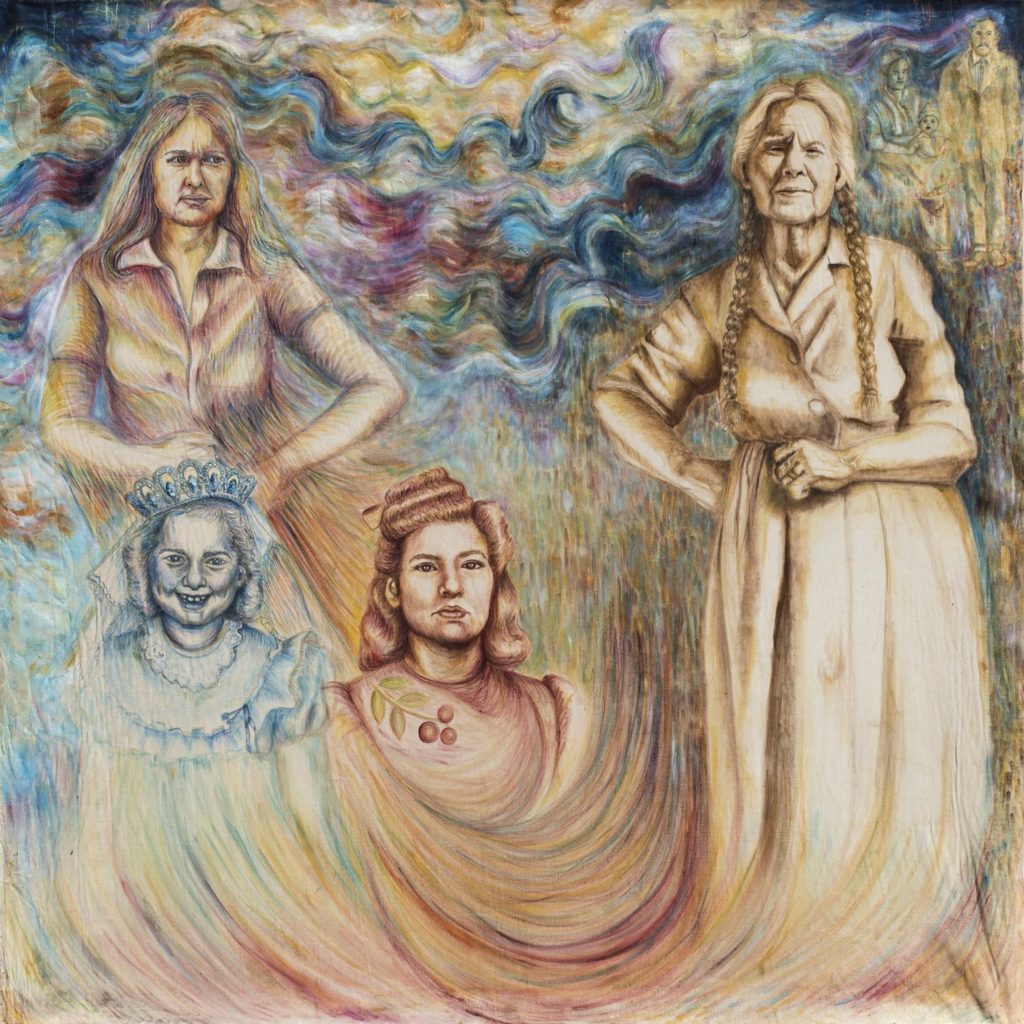
Judt Baca: Tres Generations, 1973 6ft x 8ft. Oil on canvas. Self portrait of artist with mother and grandmother (Collection of the artist)
The first of three enormous galleries presents a section on female empowerment, specifically Baca’s involvement with feminism as a political movement, gender as a perspective on the world, and her own family history as a source of inspiration and protective ancestors. In work after work, starting with the multigenerational family portrait Tres Generations (1973), we see the development of Baca’s visual language, her intentional balance of beauty and power, and the emergence of her delicate yet visceral earthly surrealism. In figure drawings and landscapes, as well as a series of cheeky performance-based self-portraits, Baca works through both her own issues and moves toward taking on the world’s.
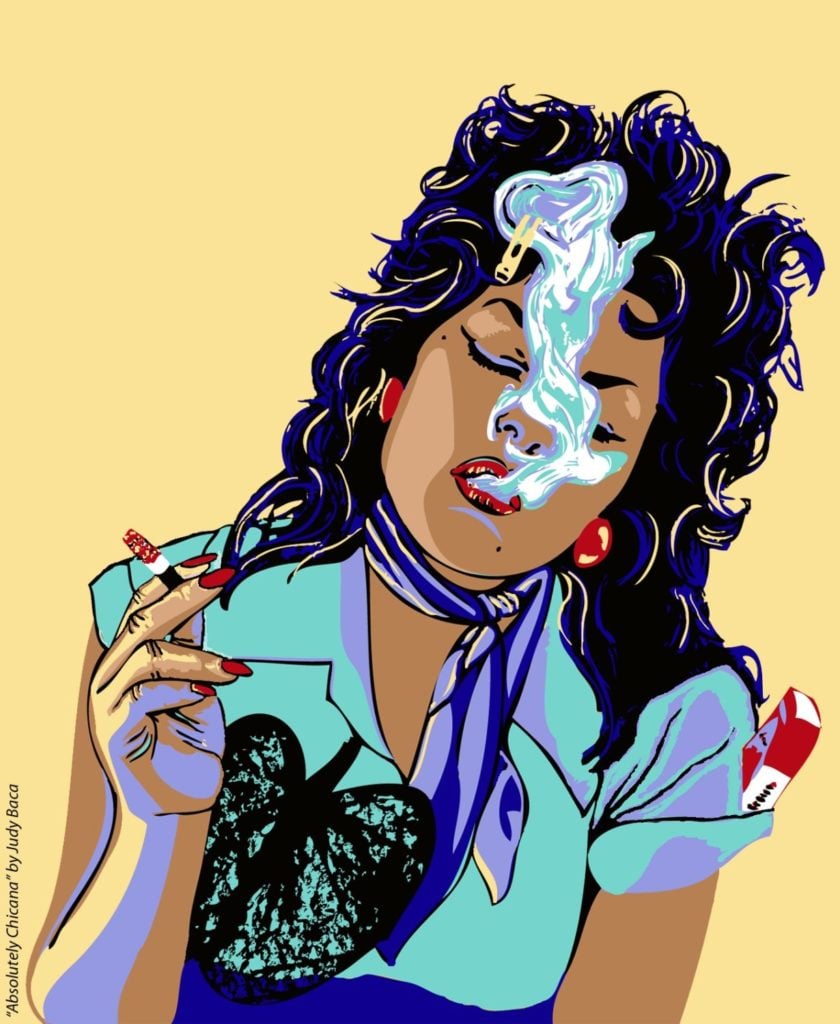
Judy Baca: Absolutely Chicana, 2008, Print
Serigraph. H 26″ x W 20″ (Collection of the artist)
A suite of beguiling never-exhibited ink drawings speaks to the intimate side of this equation, while a masterpiece called Matriarchal Mural: When God Was A Woman (acrylic on wood panels, 8 x 12 feet, 1980-2021) holds court as a cornerstone that encapsulates the whole journey. Now in the permanent collection of MOLAA, the work was completed just in time for the exhibition to open earlier this year, but Baca started working on it in 1980. A double-sided triptych is framed in a construction that allows each panel to spin to reveal the flipside composition. Thirteen Women in the Volcanic Eruption (Side 1) depicts a phalanx of female ancestors, with a very deliberate range of skin tones and features, but all nude and standing still among the lava flows, in postures of peace and offering. Schematic, stylized lines and near-symmetry give it an operatic, mythological quality that explores the power of the matrilineal legacy, within families and throughout time.
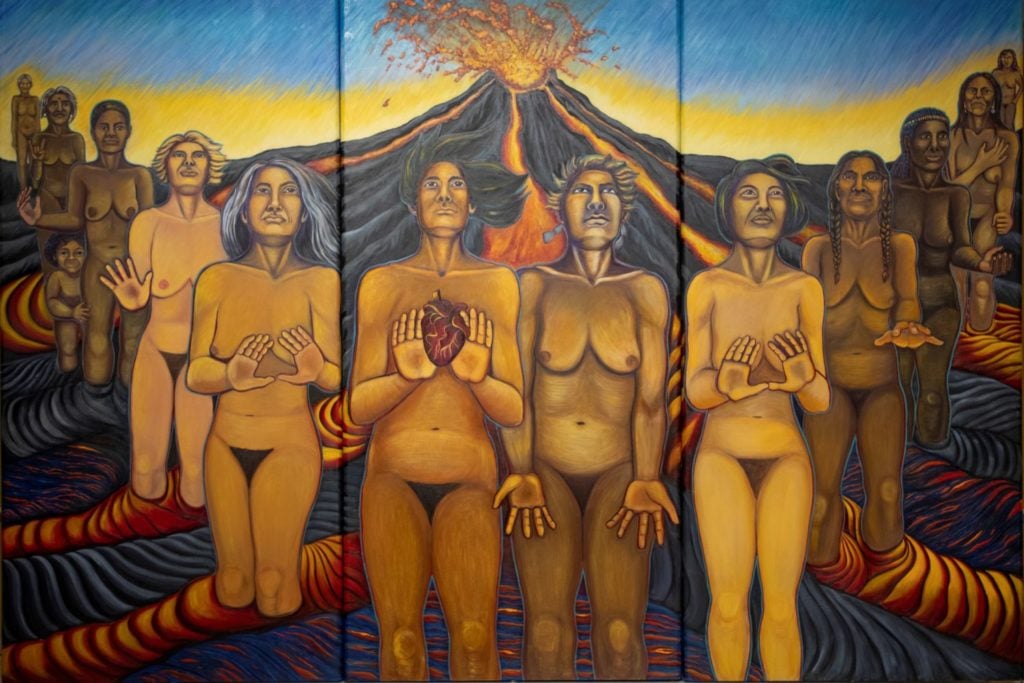
Judy Baca: Matriarchal Mural: When God Was A Woman, 1980 – 2021. Double Sided Triptych: “Thirteen Women in the Volcanic Eruption” (Side 1). Acrylic on wood panels. H 8′ x W 12′ (MOLAA Permanent Collection)
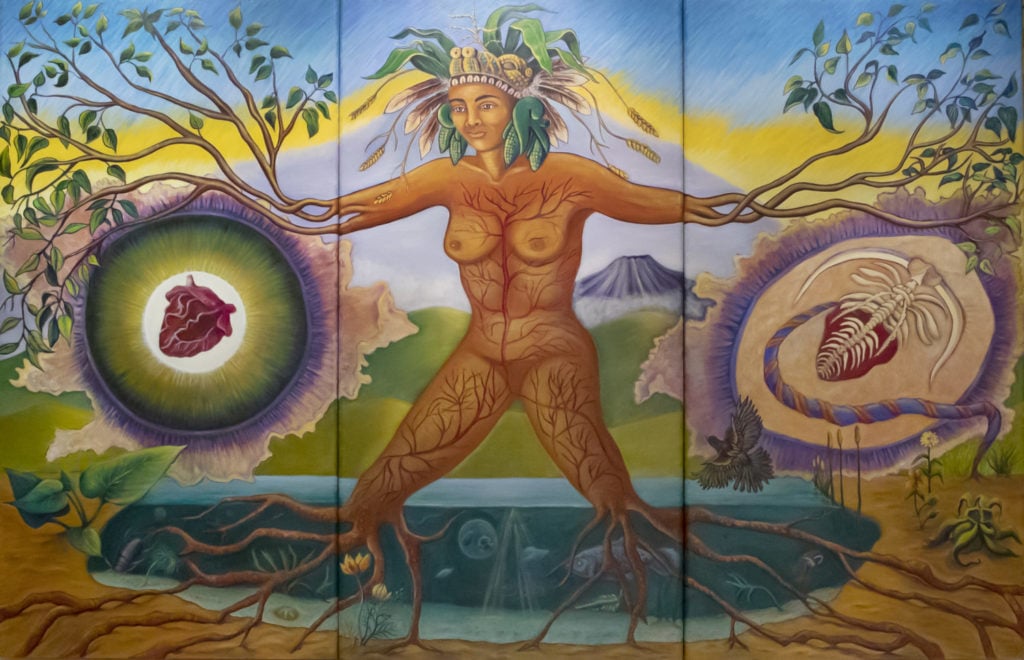
Matriarchal Mural: When God Was A Woman, 1980 – 2021. Double Sided Triptych: “The Birth of the Vision of the Heart” (Side 2). Acrylic on wood panels. H 8′ x W 12′. (MOLAA Permanent Collection)
The Birth of the Vision of the Heart (Side 2) is wildly surreal and holds its power with the strength of an invocation. A woman in a crown of corn and feathers stands astride the ground and water; her legs are rippled with dark veins that branch into tree roots, her feet are roots planted in the earth. Her arms become flowering, leafy branches, outstretched. Around her an array of human heart and vine motifs, creatures in the sea around her feet, birds in flight all frame a green, fertile expanse falling away toward a dormant volcano at the horizon. Delicate detail and rich, gradient colors speak to the living. Which side is first? Perhaps the answer is in its structure – an eternally returning cycle.
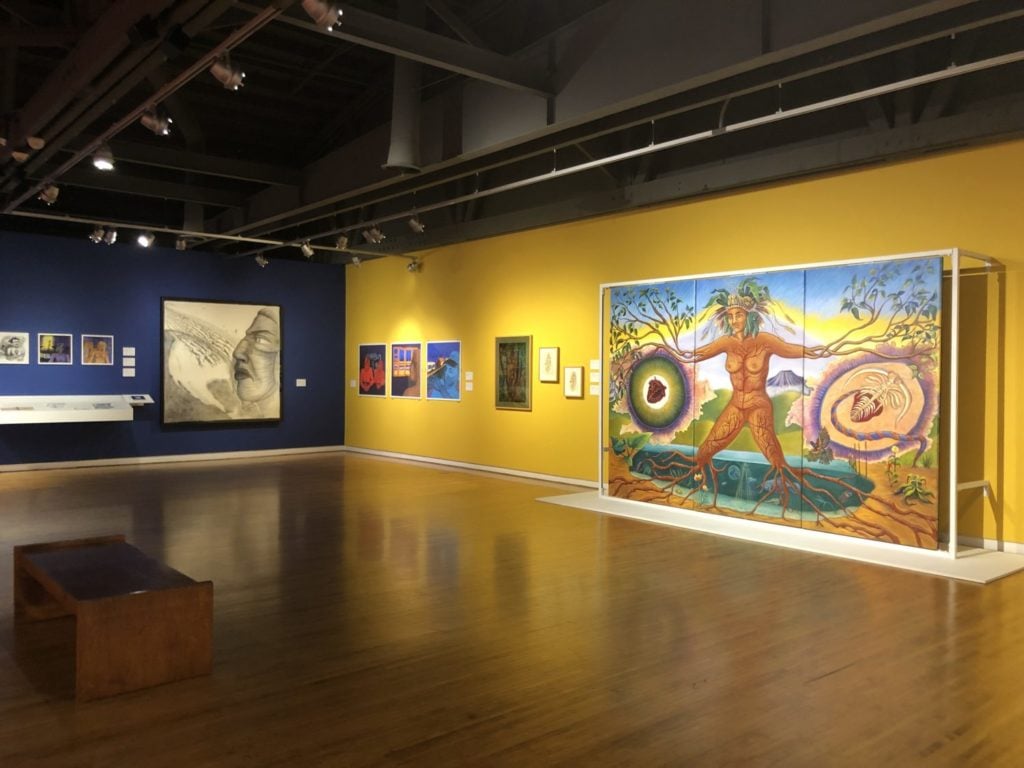
Judy Baca, installation view at MOLAA (Photo by Shana Nys Dambrot)
Toward the far end of that first gallery, Baca’s work is seen to embrace sculpture and installation elements as well, a theme that continues and expands in the next phase of the survey. A pair of elaborately painted Pancho Trinity three-part sculptures from 1993 combines a large-scale version of a ubiquitous but problematic sleeping man in a sombrero sculpture with landscape and spirit imagery such as in her paintings, depicting scenes of both bucolic beauty and darker events. Nearby, a fruit vendor’s cart is given a similar painting treatment, with the addition of a miniature barbed-wire fence, a reference to fortified, hostile borders and other kinds of imprisonment.
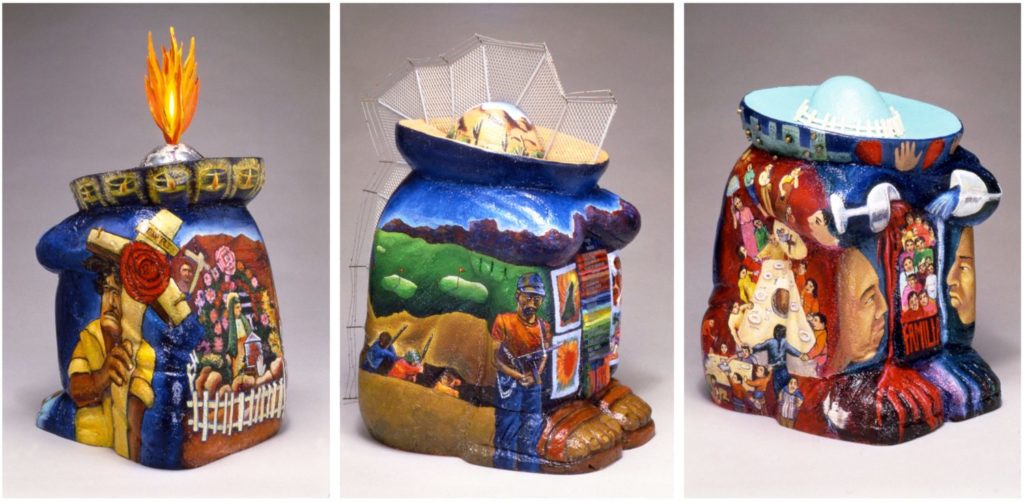
Judy Baca: Pancho Trinity 2: “El Espiritu,” “La Tierra,” “La Familia”, 1993. Acrylic paint & mixed media on urethane-coated styrofoam, 26′ x18′ x 20′ ea. (Collection of the artist)
In this context of sculpture, the scale models and large drawings rendering plans for public space and mural works eloquently connect her studio practice with her outward-facing mission. In 1974, Baca founded the city of Los Angeles’ first mural program, which produced over 400 murals and employed thousands; in 1976 it morphed into the Venice-based Social and Public Arts Resource Center, an organization that is very much in full swing to this day. They remain dedicated to seeing community and public art made by and for the actual people of the city, rather than the political elite, which often meant wealthy white men. In case there’s any doubt about whether sexism and racism are still an issue, even for someone of Baca’s status, the show includes the proposal drawings for a recent diversity-themed mural, with some very condescending notes back to her in the margins – along with her concise but laser-sharp responses. The imagining and executing of so many important public art projects, and the challenges faced by a Latina in leading that charge, undergirds not only her continuing evolution as an artist, but her commitment to collaboration.
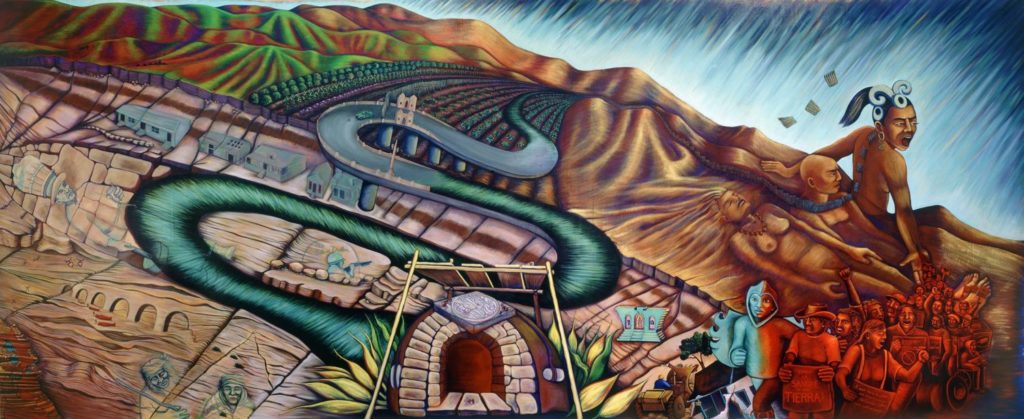
Judy Baca: “La Memoria de Nuestra Tierra, California”, 1996. 10′ x 30′. Acrylic on canvas mural located at USC.
“We have momentum right now, but nothing has changed,” Baca tells the L.A. Weekly. “I’ve been in public practice since before those words were invented [in the art world]. Community, social practice, all of that language, it’s just what we did. The true level of commitment required is a nightmare! As a social organization there was no money for art, but the art world took a while to understand it as art.” Based on the current popularity, support and attention being paid to her work, it feels like maybe everyone has finally caught up. “We work in the field,” she says. “We plant, we tend, but we never get to harvest – that’ll be for the young people to do.”
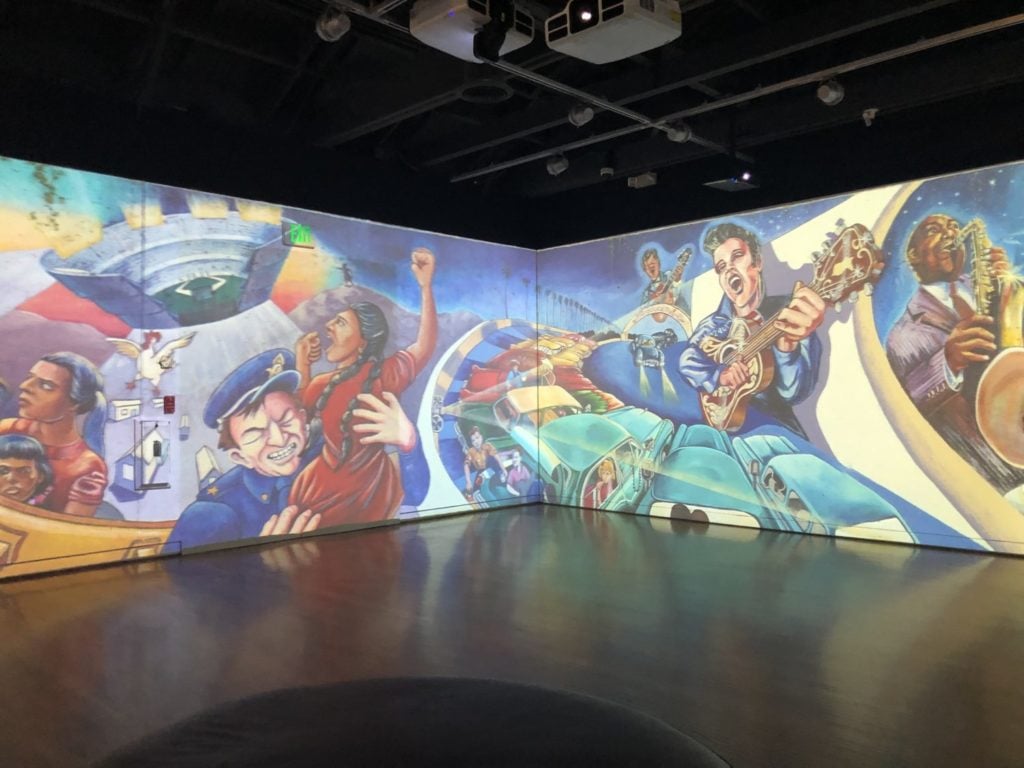
Judy Baca: Great Wall of Los Angeles audio video installation at MOLAA (Photo by Shana Nys Dambrot)
Speaking of working with the future, in the exhibition’s climax, visitors will discover the history of Baca’s great life’s work, the Great Wall of Los Angeles. To understand the vast physical scale of this project, MOLAA commissioned an immersive audiovisual version of the monumental piece. A continuous floor-to-ceiling illuminated scroll across four tall walls of a darkened room shows the entirety of the quarter-mile wonder, in perfect high-resolution and saturated technicolor, with a marvelous soundtrack and interspersed with contemporaneous video from local news (there was a rather dramatic helicopter rescue during a flood) and a PBS special from the 1980s.
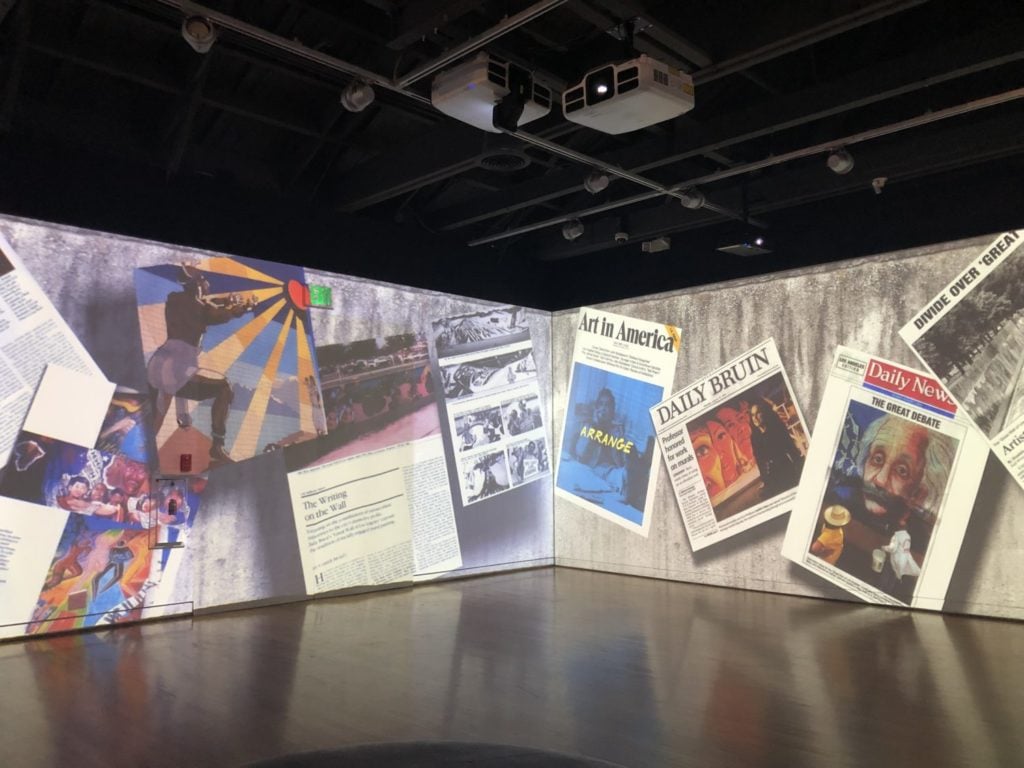
Judy Baca: Great Wall of Los Angeles audio video installation at MOLAA (Photo by Shana Nys Dambrot)
“The Great Wall is an epic recovery of the history of the true American story,” says Baca. “The amount of material missing from the official, taught accounts is… staggering. As far as the relationship of today and history, I’ve always believed, as Diego said, that the definition of a monument is to bring the past into the present to change/inspire the future.” Baca remembers in the 1970s there was an indigenous occupation of Alcatraz. “It was a community, a family gathering entirely unlike a protest. Their message was that [white men] made many promises but they only kept one – to take our land. Now I think about Standing Rock…”
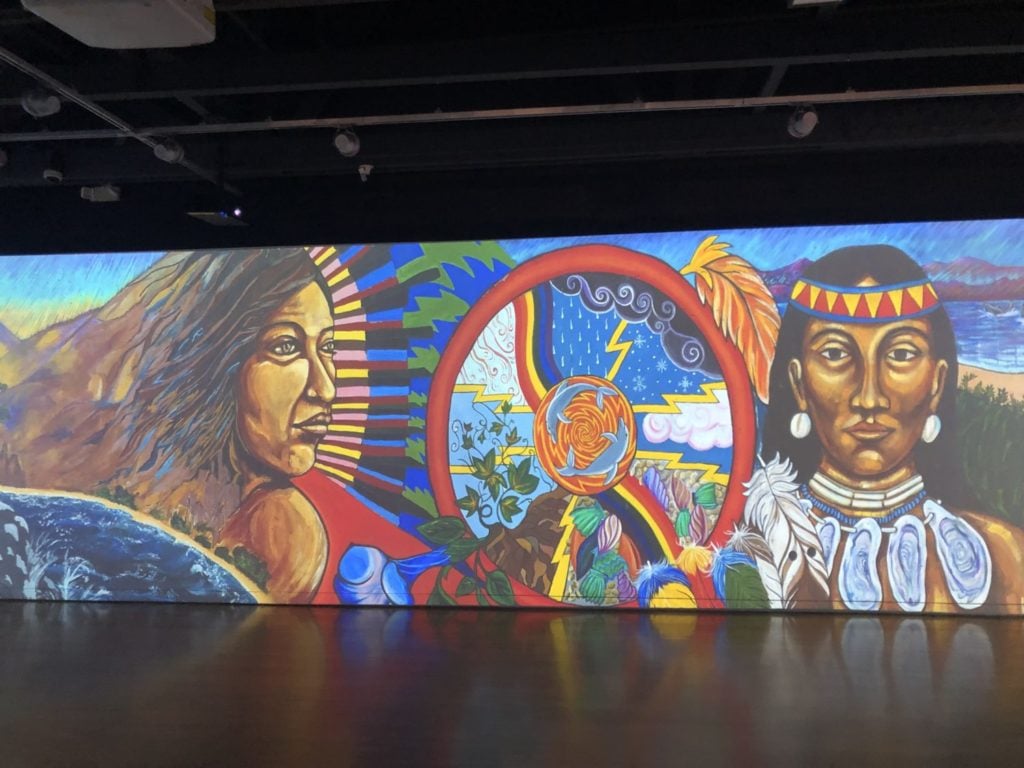
Judy Baca: Great Wall of Los Angeles video installation at MOLAA (Photo by Shana Nys Dambrot)
The Great Wall includes scenes from indigenous life, nature, agriculture, migrations, multiple wars, development, politics, sports, social movements, industry, science, popular culture, policing, patriotism, human rights and more. So how does she approach what must be the daunting task of choosing what images, scenes and figures to include, not only in the Wall but in her prolific mural practice in general? “Some are iconic,” she says, “like RFK. But it’s also crucial to include new, uncovered histories, as well as individuals and specific events – like the Fighting 442nd survivor. This was the most decorated group out of all WW2 soldiers, but they were Japanese.” They were treated badly, and for Baca that kind of wrong is worth making right. The next section, which is already well planned and in fact sketches are included in the exhibition, will take on the Civil Rights era, with a scene set at a segregated lunch counter sit-in protest. “We must depict the past with relevance for today,” says Baca. “Otherwise, how will we learn?”
Judy Baca: Memorias de Nuestra Tierra is on view through January 20202. For more information, visit: molaa.org.
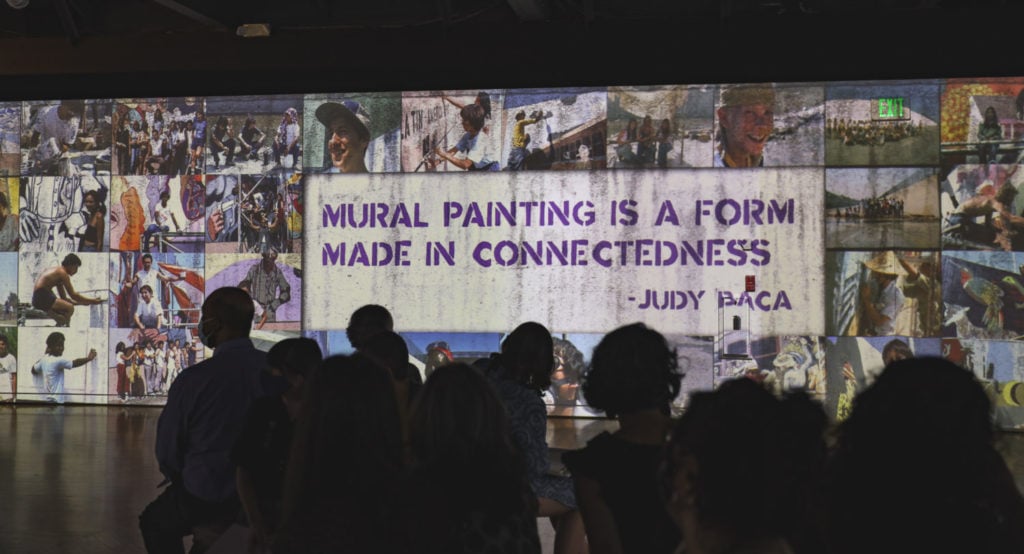
Judy Baca: Great Wall of Los Angeles audio video installation at MOLAA
Advertising disclosure: We may receive compensation for some of the links in our stories. Thank you for supporting LA Weekly and our advertisers.

